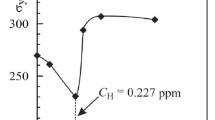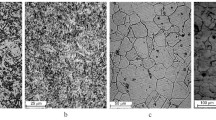Abstract
We present two methods for the investigation of the influence of hydrogen on the propagation rate of a crack and behavior of fracture of high-strength steels. The method for investigation of the influence of electrolytic hydrogenation on a subcritical growth of a crack in high-strength steels is based on the use of simple beam specimens of a certain geometry and on the application of lateral loading in such a way that the stress intensity factor can be constant at the tip of a preliminary induced crack. The method is of great importance for the performance of comparative experiments in evaluating the influence of active media and structural anisotropy of specimens made of high-strength steels with limited sizes on their corrosion crack resistance. Typical examples of the application of the method to investigation of the role of electrolytic hydrogenation in subcritical propagation of cracks and their branching in highstrength steels are given. The method for investigation of heat release under strain and fracture of hydrogenated specimens involves the use of microcalorimetric devices, which allow one to study the influence of hydrogenation on peculiarities of the kinetics of elastic and plastic strains of high-strength steels. We illustrate the efficiency of the method proposed by plotting the “load-elongation” curves and corresponding (in time) characteristics of heat release power in the process of strain and fracture of specimens made of a high-strength steel.
Similar content being viewed by others
References
S. Ya. Yarema, “On the stabilization of stresses in the vicinity of the tip of a growing crack,”Probl. Prochn., No. 8, 15–19 (1975).
J. M. Bloom, “Single-edge crack in rectangular sheet subjected to end rotations,”Appl. Mech.: Trans. ASME, Ser. E. 33, No. 3, 243–246 (1966).
V. I. Pokhmurskii, N. M. Kundrat, L. M. Bilyi, et al., “On the constancy of the stress intensity factor at the tip of a crack in the process of its propagation in a rectangular plate,”Probl. Prochn., No. 12, 59–62 (1984).
L. M. Bilyi,Change in Cyclic Crack Resistance of Steels under Electrolytic Hydrogenation [in Russian], Author's Abstract of the Candidate-Degree Thesis (Technical Sciences), L'viv (1989).
R. A. Oriani, “Hydrogen embrittlement of steel,”Ann. Rev. Mater. Sci.,8, 327–357 (1978).
V. I. Pokhmurskii and A. I. Balitskii, “Hydrogen influence upon cracking resistance and fracture, character of austenitic non-magnetic steel,” in:Proceedings of the 4th International Conf. “Hydrogen Effects on Material Behavior,” The Mineral, Metals, Materials Society, Warrendale (1990), pp. 985–990.
M. O. Speidel, “Stress corrosion cracking and corrosion fatigue fracture mechanics. Corrosion in power generating equipment,” in:Proceedings of the 8th International Brown Boweri Symp. (Baden September 1983), New York (1984), pp. 85–132.
M. O. Speidel, “Branching of subcritial cracks in metals,” in:L'Hydrogene dans les Metaux, Vol. 2, Editions Science et Industrie, Paris (1972), pp. 358–362.
A. I. Balitskii, M. Diener, R. M. Magdowski, V. I. Pokhmurskii, and M. O. Speidel, “Anisotropy of fracture toughness of austenitic high nitrogen chromium-manganese steel,” in:Abstracts of the 5th International Conf. of High Nitrogen Steels (Espoo-Stockholm, May 1998) (1988), p. 35.
L. I. Anatychuk and O. Ya. Luste,Microcalorimetry [in Russian], Vyshcha Shkola, L'viv (1981).
G. D. Cancela, F. Roquerol, and J. Roquerol, “Etude calorimetrique de la microporosite,”J. Chem. Phys.,67, 609–616 (1970).
G. B. Demidovich and A. L. Sklyankin, “Features of calorimetric investigations of adsorption on atomically clean surfaces,” in:Proceedings of the 8th All-Union Conf. on Calorimetry and Chemical Thermodynamics [in Russian], Ivanovo (1979), pp. 301–308.
E. Calvet and H. Prat,Microcalorimétrie. Application Physico-Chimiques et, Biologiques, Masson, Paris (1956).
L. I. Anatychuk,Thermoelements and Thermoelectric Devices [in Russian], Naukova Dumka, Kiev (1979).
R. O. Williams, “A deformation calorimeter,”Rev. Sci. Instrum.,31, No. 12, 1336–1341 (1960).
G. Simicki and J. L. Macqueron, “Etude d'un calorimetre destine a la messure de l'energie dissipee dans un solide connus a des contreihtes cycliques,”C. R. Acad. Sci. B,264, No. 25, 1697–1699 (1967).
J. L. While and K. Kagama, “Application of differential thermal calorimetry to measurements of stored-energy release in metals,”Rev. Sci. Instrum.,34, No. 10, 1104–1105.
L. I. Anatychuk, V. I. Lakh, and O. Ya. Luste, “A quick-operating calorimeter with vortex thermoelements,”Prib. Tekh. Éksp., No. 5, 225–227 (1974).
A. I. Balitskii, “Investigation of the processes of heat release in the course of deformation of metals in media,” in:Proceedings of the 12th Conf. of Young Scientists of Karpenko Physicomechanical Institute of the Ukrainian Academy of Sciences. Section of Physicochemical Mechanics of Materials [in Russian], Dep. in VINITI 18.04.86, No. 2832-86, L'vov (1985), pp. 13–18.
V. S. Ivanova, L. K. Gordienko, V. N. Geminov, et al.,Role of Dislocations in Strengthening and Fracture of Metals [in Russian], Nauka, Moscow (1965).
L. A. Shuvalov, A. A. Urusova, I. S. Zheludev, et al.,Modern Crystallography, Physical Properties of Crystals [in Russian], Vol. 4, Nauka, Moscow (1981).
J. F. Nye,Physical Properties of Crystals. Their Representation by Tensors and Matrices, Clarendon, Oxford (1957).
A. I. Balitskii V. I. Pokhmurskii, and Y. V. Dzioba, “Heat irradiation of mono- and polycrystalline materials during deformation and destruction process,” in:Abstracts. Fracture Mechanics: Successes and Problems, Part II, L'viv (1993), pp. 619–620.
V. I. Likhtman, P. A. Rebinder, and G. V. Karpenko,Influence of a Surface-Active Medium on the Processes of Deformation of Metals [in Russian], Academy of Sciences of the USSR, Moscow (1954).
P. A. Rebinder, V. I. Likhtman, Yu. V. Goryunov, E. D. Shchukin, L. A. Kachanova, N. V. Pertsov, and L. S. Bryukhanova,Phenomenon of Decrease in Resistance to Plastic Deformation and Spontaneous Dispersion of Solid Poly- and Monocrystalline Metals [in Russian], Certificate of Discovery No. 28 SSSR, Registered 11.02.64, Priority 26.01.56.
Additional information
Karpenko Physicomechanical Institute, Ukrainian Academy of Sciences, L'viv. Translated from Fizyko-Khimichna Mekhanika Materialiv, Vol. 34, No. 4, pp. 113–120, July–August, 1998
Rights and permissions
About this article
Cite this article
Balyts'kyi, O.I. Two methods of investigation of the influence of hydrogen on the propagation rate of a crack and behavior of fracture of high-strength steels. Mater Sci 34, 574–583 (1998). https://doi.org/10.1007/BF02360710
Received:
Issue Date:
DOI: https://doi.org/10.1007/BF02360710




